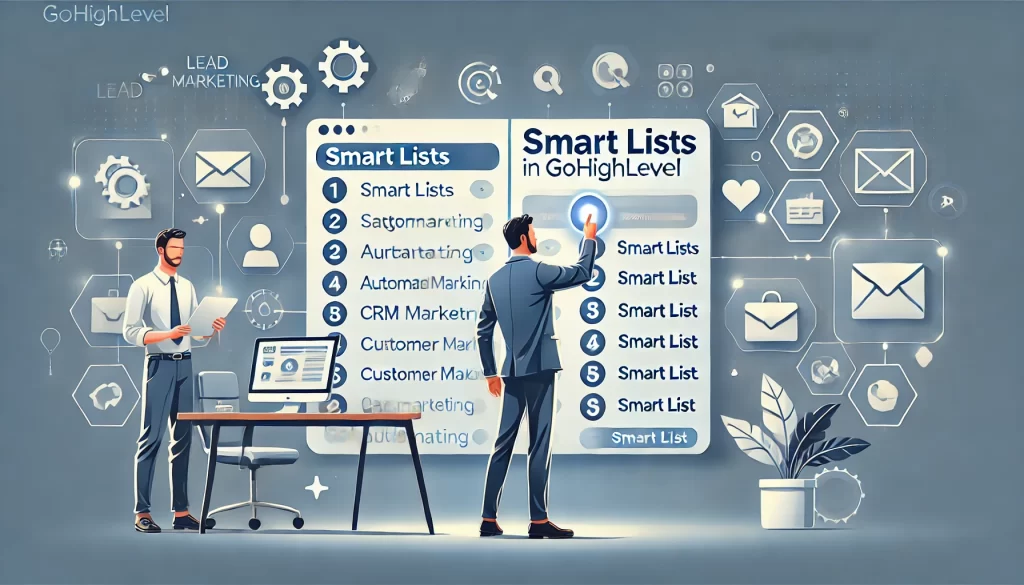In today’s marketing world, the more personalized your approach, the better your results. But how do you make sure you’re reaching the right customers with the right message at the right time? That’s where smart lists come in.
A smart list is a dynamic list that automatically updates based on criteria you set in GoHighLevel. It allows you to segment your contacts and leads based on specific behaviors, actions, and attributes. Whether it’s a group of customers who clicked on your latest email campaign or those who visited your website within the past week, a smart list makes it easier for marketers to automate outreach and optimize engagement.
By automating segmentation with smart lists, businesses can create targeted campaigns that improve lead nurturing, increase conversions, and enhance customer retention—all with minimal manual effort. In this article, we’ll walk you through how to create and use smart lists within GoHighLevel, best practices for their use, and why they’re such an essential tool for effective marketing.

Step-by-Step Guide: How to Create and Use Smart Lists in GoHighLevel
Creating a smart list in GoHighLevel is simple once you understand the process and the various criteria you can use. Let’s dive into the steps to get you started:
Related Posts
Step 1: Log into GoHighLevel
To begin, log into your GoHighLevel account. If you don’t have one yet, you can sign up for a free trial to explore its features.
Step 2: Navigate to the Contacts Section
Once you’re logged in, head over to the Contacts section from the left-hand menu. This is where you’ll manage your leads and create the necessary lists for segmentation.
Step 3: Create a New Smart List
On the contacts page, you’ll find an option to “Create Smart List”. Click this to begin setting up your smart list.
Step 4: Define Your Criteria
This is where the magic happens. The criteria you set will determine which contacts will be included in the smart list. You can filter contacts based on several attributes, including:

- Lead source (where the contact came from, e.g., Facebook Ads, organic search, etc.)
- Custom fields (like contact tags, lead score, or customer type)
- Actions (such as email opens, clicks, form submissions, etc.)
- Website activity (like pages visited, time spent on your site, etc.)
Step 5: Customize Your Smart List
Once you’ve set your criteria, you can further customize the list based on specific dates or other attributes. GoHighLevel allows you to use AND and OR logic for more detailed segmentation.
For example, you might create a smart list of users who have clicked on a specific email link AND visited your pricing page in the last 30 days. Or, you could create a list of leads who meet any of several criteria, like attending a webinar OR downloading a case study.
Step 6: Save and Name Your Smart List
Once you’re happy with the filters and criteria, you can save the smart list and give it a name that clearly defines the group of contacts it represents. This will help you quickly identify and use the list later.
Step 7: Use Your Smart List for Marketing Campaigns
Now that you’ve created your smart list, it’s time to use it. You can trigger email or SMS campaigns, set up automated workflows, or simply monitor and track the behavior of this segmented group.
Step 8: Continuously Update Your Smart List
As time goes on, the list will automatically update based on your set criteria. For instance, if you created a list based on a specific action like downloading a PDF, any new lead that meets the criteria will be added automatically. This ensures your lists are always up to date without needing to manually track every change.

Best Practices: Tips for Effectively Using Smart Lists to Segment Customers
Creating a smart list is only the beginning; how you use it can make all the difference in your marketing efforts. Below are some best practices to maximize the power of smart lists in GoHighLevel:
1. Use Smart Lists for Personalized Communication
Segmentation is key to delivering personalized messages. Instead of sending generic emails to your entire contact base, create smart lists to target specific behaviors or interests. For example, if someone recently signed up for a free trial, you can create a list of these users and send them a tailored onboarding email series.
2. Leverage Smart Lists for Lead Scoring
Lead scoring is a valuable tool for prioritizing which leads to focus on. By setting up smart lists based on lead score or activity level, you can focus your efforts on high-potential leads who are more likely to convert.
3. Automate Lead Nurturing
Smart lists can be powerful when integrated with GoHighLevel’s automation features. For instance, once a contact is added to a smart list based on specific actions, you can trigger a series of automated emails or SMS messages to nurture the lead. This keeps your business top of mind without you having to manually follow up.
4. Regularly Update Your Smart Lists
While smart lists are automated, it’s important to review and update them regularly to ensure they’re still relevant. Behavior patterns and customer needs change over time, so it’s essential to adjust your criteria and lists as necessary.
5. Test Different Criteria for Better Segmentation
Try experimenting with different segmentation criteria to identify what resonates best with your audience. For instance, you could create lists based on geographic location, job title, or even interactions with a specific piece of content like an eBook download or webinar participation.
6. Use Smart Lists for Upselling and Cross-Selling
Smart lists aren’t just for lead generation—they can also be used for upselling or cross-selling. By grouping existing customers who are likely to benefit from an upgrade or additional service, you can create targeted campaigns designed to maximize lifetime customer value.
How Smart Lists Help with Managing Leads and Automating Marketing
In conclusion, smart lists are one of the most powerful tools within GoHighLevel for lead management and marketing automation. By segmenting your contacts based on specific behaviors, actions, and attributes, you can deliver more personalized, relevant marketing campaigns that drive higher engagement and conversions.
By creating smart lists, you can automate your marketing workflows, segment customers for better targeting, and ensure your messages reach the right people at the right time. With minimal manual effort, GoHighLevel’s smart lists streamline your marketing and make it more effective. Whether you’re nurturing leads, following up with prospects, or promoting new offers, smart lists help you stay organized and achieve your goals.
FAQs
What is the difference between a regular list and a smart list in GoHighLevel?
A regular list in GoHighLevel is static, meaning contacts must be added manually. A smart list, on the other hand, is dynamic and automatically updates based on defined criteria such as actions, tags, or custom fields.
Can I use smart lists for automating emails in GoHighLevel?
Yes, smart lists are perfect for automating emails and other communications. Once a contact meets the criteria of your smart list, you can trigger a series of emails or SMS messages without manual intervention.
Can I create a smart list based on website activity?
Yes, you can create smart lists in GoHighLevel based on website behavior, such as pages visited, time spent on the site, or whether a contact has submitted a form.
How often does GoHighLevel update smart lists?
Smart lists in GoHighLevel update automatically in real time. As soon as a contact meets the criteria you’ve set, they will be added to the list, and any changes in their status will be reflected immediately.
Is there a limit to the number of smart lists I can create in GoHighLevel?
GoHighLevel doesn’t have a strict limit on the number of smart lists you can create, but the number of lists may depend on your plan’s limitations regarding features and integrations.
Related Posts
Key Takeaways
- GoHighLevel smart lists offer a powerful and automated way to segment your contacts for better targeting and personalization.
- By defining specific criteria, you can ensure that your marketing messages reach the right people, at the right time, and with the right offer.
- Best practices include regularly updating your smart lists, using them for lead scoring, and automating communication to save time and boost conversions.
